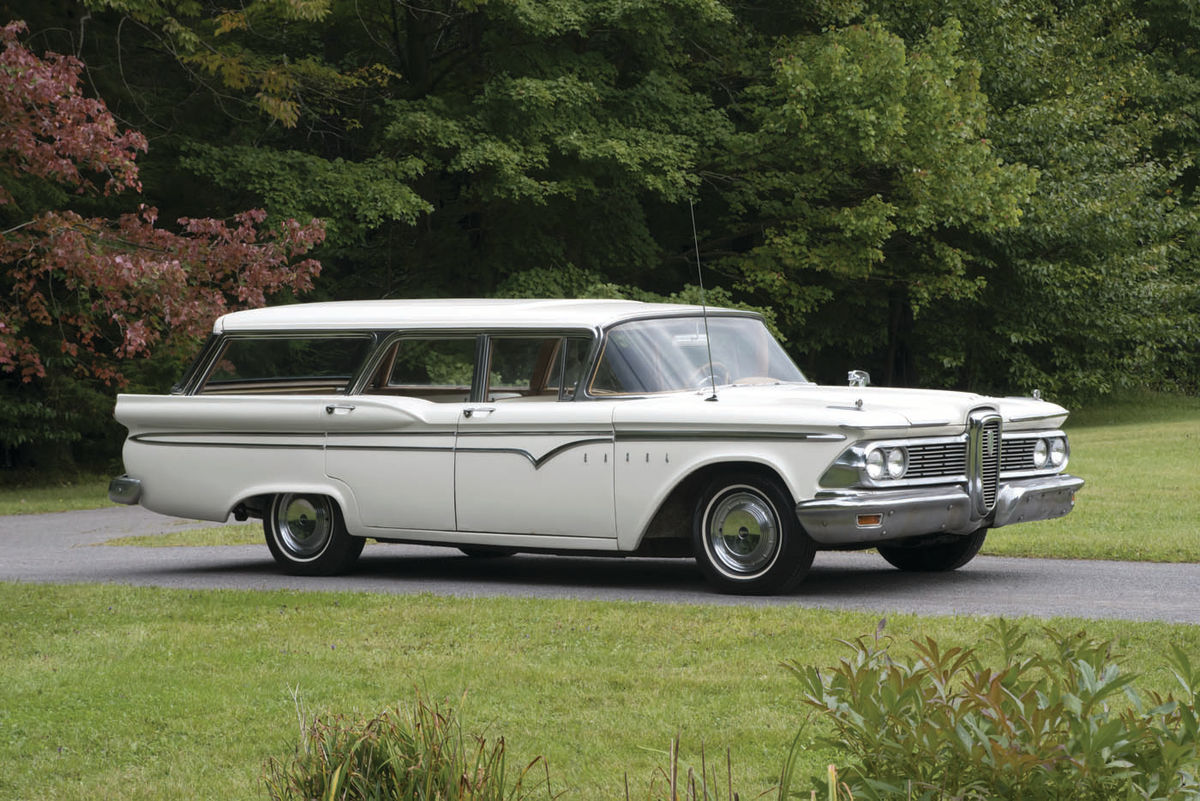1959 EDSEL VILLAGER
This Wagon Has Been In the Same Family for Six Decades…and It’s One of Several That the Family Has Owned.
There was a time when standup comedians were assured of a good laugh by describing an Edsel as an Oldsmobile sucking a lemon— or worse—while more serious types were applauded for pronouncing it a symbol of failure. Jokes and cliches aren’t always on-target, of course, and sometimes they rely on an audience that doesn’t know much about the subject matter.
“I pulled into the gas station near my house,” said Craig Wood, whose 1959 Villager is shown here, “and while I was getting gas, I walked in to pay for it. It was all young-generation, Young New Yorkers coming up from the city, ‘what is that?’ I say ‘it’s a 1959 Edsel station wagon.’ ‘What is that’ is all you hear. ‘What’s an Edsel?’ They have no idea.”
Nearly 60 years after the last example was built, the Edsel and its story are probably most familiar to those whose grasp of automotive history or business history is solid enough to tell them that the derision and tales of woe that once surrounded the car aren’t quite fair or completely accurate. If, like those young drivers Wood met at that gas station in the Pocono Mountains, they don’t know what an Edsel is, they probably don’t know anything about the general attitude that was once aimed at the car and they probably don’t know much about where the Edsel came from, either.
Seeking a Competitive Lineup
Ford was following a carefully thoughtout plan when in the early 1950s, it began to expand its lineup into something roughly comparable to and competitive with that of General Motors.
At the top would be the Continental Mark II, the spiritual descendant of the prewar Continental that had reappeared after World War II, still relying on a V-12 that was now the last of its type in an American car.
That would take care of the high end where Cadillac was holding off not only Lincoln, but Packard and the Chrysler Imperial, but there was still the midrange market in which Ford had only the Mercury to go up against Buick, Oldsmobile and Pontiac, not to mention Dodge and DeSoto and medium-price Packards.
Ford couldn’t allow that to continue and the obvious solution was to create another new car. It would have to be somewhere in Mercury territory in terms of price and would need to be sufficiently distinctive to show that it was more than merely a Ford or Mercury that had been tweaked. It would have to be different.
Starting at the Top
The Continental Mark II—the previous Continental became the Mark I in retrospect—arrived for the 1956 model year. Cleanly styled with straight lines, smooth edges and minimal chrome, it wore the longhood-short-deck proportions that would later appear on the Mustang and its competitors. It was a design that met with almost universal approval and remains revered by many today, but Ford was unable to translate that acceptance into sales. No doubt that was due at least in part to the Continental’s $10,000 price tag (about $90,000 in today’s dollars), but with 2556 cars sold in 1956 and 444 in 1957, the company decided that it had had enough and the exclusive coupe was succeeded by a Lincoln-based Continental Mark III for 1958. The Mark IV that followed in 1959 was a Lincoln, but while all of that was happening, the car that would become the Edsel was moving ahead.
Make Way for the Edsel
Ford’s faith in the Edsel remained unshaken by what had to have been a painful disappointment in the Continental, but before the exclusive luxury car faded away, a November 24, 1956 article in Business Week stated that the Edsel’s planning had actually begun in 1948, only to be interrupted by the Korean War. The same article also observed that the newly established Edsel Division’s “staff, ironically, is taking over the former Continental Division offices, since that division has been abolished and the Continental car restored to the Lincoln line.”
As the Edsel’s unveiling approached, promotion built the car up in the public’s collective mind. One ad spoke of hundreds of thousands of miles of testing on and off the road in heat and cold, promising that “by the time it reaches your streets, the Edsel will be one of the best-tested, best-proved cars in automobiling history. And that time is not far off.”
That time finally came on September 4, 1957, when the Edsel appeared as the Ford-based “Junior” Ranger and Pacer alongside of the larger Mercury-based “Senior” Corsair and Citation as well as the Roundup, Villager and Bermuda wagons on the smaller platform.
Advertising stated that “they’ll know you’ve arrived when you drive up in an Edsel. Other drivers spot that classic vertical grille a block away—and never fail to take a long look at this year’s most exciting car.” It was all true, but maybe not for the reasons the copywriter had in mind, although to be fair, the Edsel wasn’t the only 1958 car whose styling tilted toward the outrageous and its look wasn’t instantly panned. Business Week, not a magazine given to sensation or unbalanced reporting, told readers three months after the Edsel’s introduction that opinions ranged from shocking-butgrows-on-you to “a restrained, classic look” to the belief that the styling—but not the price— appealed to younger drivers.
More telling was the fact that the article also quoted a dealer who saw a bigger picture. The medium-price market, the dealer told the magazine, does well in good times and takes a big hit in an economic downturn.
“When they dreamed up the Edsel” the dealer said, “medium-priced cars were a big market, but by the time the baby was born, that market had gone helter-skelter.”
Initial quality-control problems surely impacted its reputation but the Edsel had the misfortune to go on sale during a recession after a carefully orchestrated pre-launch campaign over several years created an expectation that few cars, if any, could hope to meet. The result was that just 63,110 Edsels were sold in that first model year, but Ford didn’t immediately give up.
A Simplified Approach
When the 1959 model year opened, the new cars had been simplified and Edsel was now “the car that makes history by making sense.” The Pacer, Corsair, Roundup and Bermuda were gone and all Edsels were now built on the Ford platform. The vertical center grille was simplified and combined with the headlights that had been relocated from the fenders to the grille to create a much cleaner front view. At rear, the former high horizontal taillights that dipped at their inside edges were replaced by two round taillights and one backup light per side, all mounted midlevel in a chrome housing. Sheet metal was less sculpted, gimmicks such as the drum speedometer that turned red above a preselected speed and the Teletouch Drive which selected a transmission range via buttons in the center of the steering wheel were gone. Under the hood, the 430-cubic-inch V-8 in the 1958 Corsair and Citation was dropped, but the 361 from the Ranger, Pacer and wagons returned and was joined by 292 and 332 V-8s as well as a 223-cubic-inch six. It was a “new wide selection in economy-minded Edsel power” and “economy” appeared in every engine description on the page.

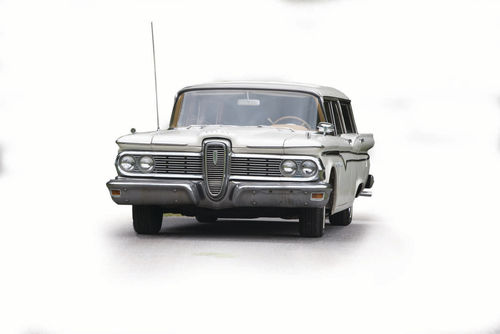
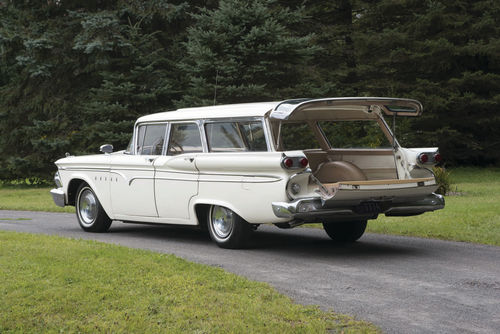
“Here, at last, is the car that had to happen,” the same brochure announced, “a new breed of car that makes history by making sense in every beautiful detail. Now, you can own a quality automobile in styling, performance, workmanship—yet pay no more than you would for other cars in the low price range.” There was now a marked change in the car’s target market, as prices across the range were now between $2600 and $3100.
A handout called Edsel Extra boasted that “car buyers are thinking more and more in terms of the low-priced Edsel. Latest figures show that Edsel sales continue to exceed the same months last year…never before has an automobile offered the American car buyer so much for so little as the ’59 Edsel.” But thinking in terms of the Edsel didn’t automatically translate to buying one and the model year ended with 44,891 sales.
It was no wonder that the 1960 Edsel—looking even more like a Ford—was down to just the Ranger and Villager. It was “new—nifty—thrifty.” but it had little chance to prove itself as the last example was built on November 19, 1959, one month and four days after “Back in 1960,” Wood said, “he found it. I guess he had read about it in the paper, that they had a leftover Edsel at a dealership in Port Jervis, New York.”
Wood guessed that his father owned four Edsels at the time and added that he remembers a total of seven while he was growing up. But even that isn’t the whole picture as there were several others that were junked. Out of the fleet, he said, the feature car was the favorite and being a station wagon, it was the Edsel that was taken on family trips. He recalled regular runs from his parents’ farm in Boyd’s Mills, Pennsylvania, to visit relatives in Binghamton, New York, a drive just long enough that his mother would pack a picnic lunch.
Then…An Edsel Inheritance
By about 1973, he said, the wagon was no longer on the road regularly, although it was anything but forgotten. Instead, it was carefully stored for years under cover in the barn or a shed, occasionally started and taken out for a time before being returned to its protected place. Even that doesn’t completely show how his father felt about the Edsel.
“He loved that car,” Wood said, “and every time I wanted to go down and start it, ‘nope, I’ll be right down.’ No matter how old he was, ‘I’ll start the car.’”
His father passed several years ago and by then, only the feature car and a 1959 Ranger sedan remained. He’d at first wanted the Ranger, but his brother, Mike, suggested that the Villager with its automatic would be a better choice. His other brother, Bob, took the Ranger with its manual threespeed and the Villager was placed on a rollback for the trip to Wood’s home in Covington Township about an hour away. Neighbors, he figured, had probably forgotten about the car.
“They knew the car,” he said, “but I don’t think they ever knew what happened to the car. To go slow down the street and to see neighbors who were outside as it was going, looking up and pointing at it, they remembered the car.”
His First Time Behind the Wheel
The Edsel wore a thick layer of dust from its years of sitting, but that was deceiving.
“After washing it for the first time,” Wood said, “it was like a brand-new car on the assembly line. It just shined. Every part of that car shined. It was like I’d just gotten done waxing it and all I did was wash it off. It was just so cool.”
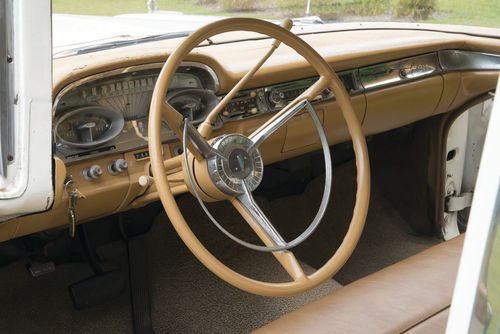
Not everything went that well, though, as Wood said he was surprised at how little work was necessary to start the 332. It ran, but it coughed, backfired and knocked, which wasn’t the problem it might have been for him. The engine, he explained, had come from a 1959 Ford and he’d forgotten about the original 332.
“The original engine,” he said, “was taken out back in the late ’70s, but my dad put it away. He knew that one day he would like to rebuild it. I’d forgotten that the original engine even existed. I had no idea and Mike told me it was out in the barn, stored, that Dad had covered it. It was sitting there if I wanted to have it rebuilt. I had it rebuilt and I put it back in the car.”
At the same time, the transmission was rebuilt as a precaution although it had given no indications of even minor problems. The interior hadn’t held up quite as well, so the seats were reupholstered and soon after the Edsel was back in service and making its test run over local back roads. It was the first time the car was being driven since coming out of storage…and the first time that Wood had driven it.
There was the sense of accomplishment and excitement that anyone would feel in that situation, but he recalled that the only thing he’d forgotten about was the gas tank and that led to several unplanned stops to clear the debris that had choked the fuel supply. Those unplanned stops were the only ones since the goal was to identify any work that was still necessary and he said the Edsel made it home under its own power. His wife, Michelle, was waiting for him.
“She’d waved to me as if a ship was leaving,” he laughed. “She’d said ‘if there are any problems, let me know,’ but 15 minutes into the ride, my phone’s ringing and I didn’t want to let go of this big, big steering wheel to answer it, so she was worried about me and yes, she was waiting when I came back.”
Drive One…It’s Definitely Not a “Loser”
Few, of course, are going to find an Edsel wagon in the family barn and fewer still are going to find one with a solid body, all of its trim and the original engine awaiting a rebuild. Those who do come across a Villager like Wood’s are for two reasons likely to be confronted with a car that needs attention. One problem is that the reputation that attached itself to Edsels led to poor resale values and many were driven to death. The other problem is that Edsels are as prone to rust as nearly all of their contemporaries. The typical rust points are those that would show up on most cars of the time, such as the quarter panels, rocker panels, lower fenders and behind the trim. But the leading edges of the fenders above and below the trim are worth a close look since they often deteriorated early and were patched while the car was still in daily use. Damage in the door bottoms and the tailgate bottom isn’t necessarily a deal-breaker, but the bottoms of the pillars at the openings will present a much bigger challenge in dealing with rust.
Balance all of that, though, with some extremely good news beginning with the fact that nothing about the drivetrain in a 1959 Edsel is exotic or even unusual. Both the V-8s and the sixes can be described at the very least as rugged and the same is true of the rest of the drivetrain. The best mechanical news is the fact that three of the available V-8s and the six are everyday Ford engines and the Edsel-exclusive 361 is an overbored 352, but then there’s the sheet metal.
Even a quick glance at the Villager reveals that from the firewall back, it’s mostly a Ford. The positions of the taillights and reverse lights are switched between the two cars and that could fool the casual observer seeing only a rear view, but the interchangeability that does exist between them is a plus. Finding a Ford wagon as a donor car would probably require some hunting, but if Wood’s experience is any guide, finding a Villager parts car might become a longterm project in itself. He returned to the encounter with the young people who had no idea what he was driving that day in the Poconos.
“What I saw up there at the gas station,” he said, “was the older generation saying ‘my gosh, I haven’t seen one of them in years.’ ‘Where did you get that?’ And the last thing, ‘I never saw a station wagon.’”
Other comments, he said, would cover the range of those that nearly every collector car inspires as those who see it try to identify it, scratch their heads upon seeing the nameplate or wonder whether it’s restored or original.
“You’d hear everything,” he guessed, “but I think the majority would be ‘wow! A station wagon! We haven’t seen a station wagon in years.’”
Fewer people will be able to say that, as he plans to show the car and just drive it more often.
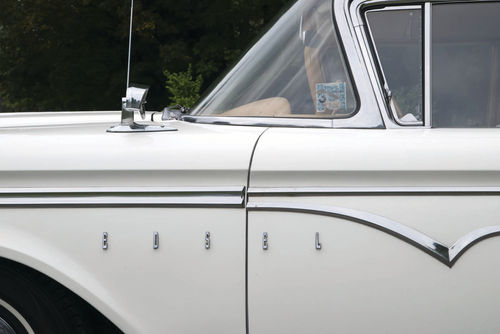
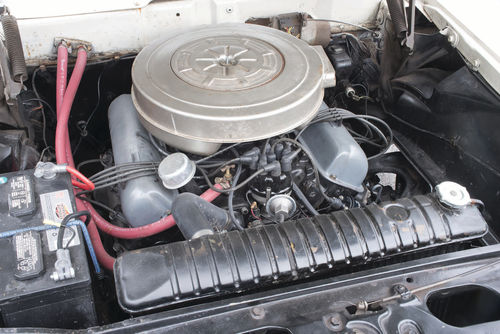
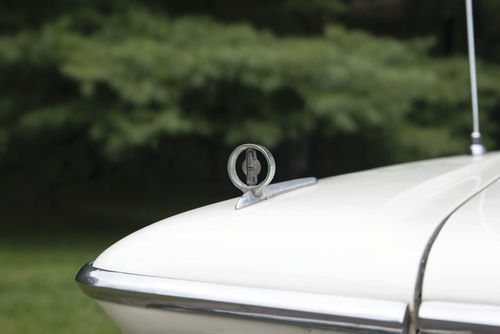
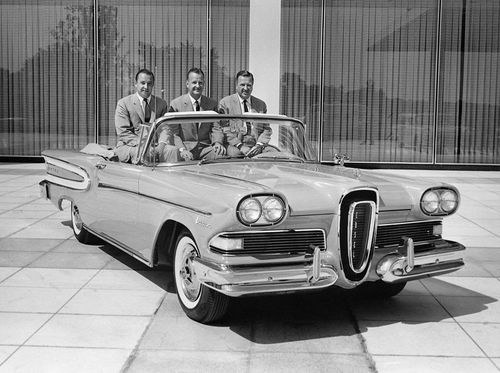
“It’s just an incredible ride, an incredible feel,” he observed, “and it’s an incredible escape. You get in that car and you’re not in 2018 anymore. You’re back in 1959. It’s a great feeling, it really is. It brings back yesteryear, in fact, my childhood. It brings back hearing my dad’s voice, especially saying ‘you’re not driving the car.’ It brings back the big family trips. There was a whole family going to the same place on vacation and all the kids were in the back and you knew you were going to see Dad turn around, ‘we’re not there yet.’”
His father, he said, must have been thrilled to find the Villager at the dealership and then to know that he was the first owner. That was 74,000 miles ago and he said that his father would be equally pleased to know that it’s still in the family and isn’t going to leave.
“It’s a family thing,” he said. “You’re not a Wood unless you have an Edsel. “Are you Don Wood’s boy? And you have an Edsel?’ That’s exactly what it is.”
He’s not clear on why his father found himself drawn to Edsels, but said the same attraction works just as strongly on him today.
“Whatever bond my father had with the Edsel,” he explained, “I inherited. I defend that car and I think the only reason why is because growing up, I heard so many people saying ‘it’s such a loser.’ There was nothing wrong with that car.”
When the time came for him to acquire one of his father’s Edsels as mentioned above, he didn’t need to be convinced. Instead, he needed to be guided.
“Mike pushed me toward the station wagon,” Wood said, “and I’m glad he did. I love the car.”

